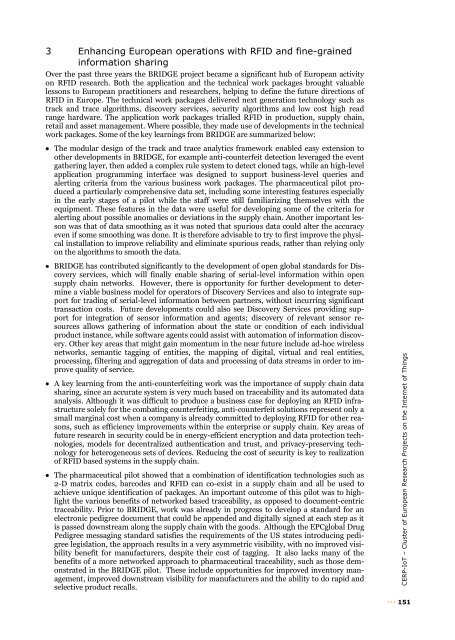Vision and Challenges for Realising the Internet of Things
Vision and Challenges for Realising the Internet of Things
Vision and Challenges for Realising the Internet of Things
Create successful ePaper yourself
Turn your PDF publications into a flip-book with our unique Google optimized e-Paper software.
3 Enhancing European operations with RFID <strong>and</strong> fine-grained<br />
in<strong>for</strong>mation sharing<br />
Over <strong>the</strong> past three years <strong>the</strong> BRIDGE project became a significant hub <strong>of</strong> European activity<br />
on RFID research. Both <strong>the</strong> application <strong>and</strong> <strong>the</strong> technical work packages brought valuable<br />
lessons to European practitioners <strong>and</strong> researchers, helping to define <strong>the</strong> future directions <strong>of</strong><br />
RFID in Europe. The technical work packages delivered next generation technology such as<br />
track <strong>and</strong> trace algorithms, discovery services, security algorithms <strong>and</strong> low cost high read<br />
range hardware. The application work packages trialled RFID in production, supply chain,<br />
retail <strong>and</strong> asset management. Where possible, <strong>the</strong>y made use <strong>of</strong> developments in <strong>the</strong> technical<br />
work packages. Some <strong>of</strong> <strong>the</strong> key learnings from BRIDGE are summarized below:<br />
The modular design <strong>of</strong> <strong>the</strong> track <strong>and</strong> trace analytics framework enabled easy extension to<br />
o<strong>the</strong>r developments in BRIDGE, <strong>for</strong> example anti-counterfeit detection leveraged <strong>the</strong> event<br />
ga<strong>the</strong>ring layer, <strong>the</strong>n added a complex rule system to detect cloned tags, while an high-level<br />
application programming interface was designed to support business-level queries <strong>and</strong><br />
alerting criteria from <strong>the</strong> various business work packages. The pharmaceutical pilot produced<br />
a particularly comprehensive data set, including some interesting features especially<br />
in <strong>the</strong> early stages <strong>of</strong> a pilot while <strong>the</strong> staff were still familiarizing <strong>the</strong>mselves with <strong>the</strong><br />
equipment. These features in <strong>the</strong> data were useful <strong>for</strong> developing some <strong>of</strong> <strong>the</strong> criteria <strong>for</strong><br />
alerting about possible anomalies or deviations in <strong>the</strong> supply chain. Ano<strong>the</strong>r important lesson<br />
was that <strong>of</strong> data smoothing as it was noted that spurious data could alter <strong>the</strong> accuracy<br />
even if some smoothing was done. It is <strong>the</strong>re<strong>for</strong>e advisable to try to first improve <strong>the</strong> physical<br />
installation to improve reliability <strong>and</strong> eliminate spurious reads, ra<strong>the</strong>r than relying only<br />
on <strong>the</strong> algorithms to smooth <strong>the</strong> data.<br />
BRIDGE has contributed significantly to <strong>the</strong> development <strong>of</strong> open global st<strong>and</strong>ards <strong>for</strong> Discovery<br />
services, which will finally enable sharing <strong>of</strong> serial-level in<strong>for</strong>mation within open<br />
supply chain networks. However, <strong>the</strong>re is opportunity <strong>for</strong> fur<strong>the</strong>r development to determine<br />
a viable business model <strong>for</strong> operators <strong>of</strong> Discovery Services <strong>and</strong> also to integrate support<br />
<strong>for</strong> trading <strong>of</strong> serial-level in<strong>for</strong>mation between partners, without incurring significant<br />
transaction costs. Future developments could also see Discovery Services providing support<br />
<strong>for</strong> integration <strong>of</strong> sensor in<strong>for</strong>mation <strong>and</strong> agents; discovery <strong>of</strong> relevant sensor resources<br />
allows ga<strong>the</strong>ring <strong>of</strong> in<strong>for</strong>mation about <strong>the</strong> state or condition <strong>of</strong> each individual<br />
product instance, while s<strong>of</strong>tware agents could assist with automation <strong>of</strong> in<strong>for</strong>mation discovery.<br />
O<strong>the</strong>r key areas that might gain momentum in <strong>the</strong> near future include ad-hoc wireless<br />
networks, semantic tagging <strong>of</strong> entities, <strong>the</strong> mapping <strong>of</strong> digital, virtual <strong>and</strong> real entities,<br />
processing, filtering <strong>and</strong> aggregation <strong>of</strong> data <strong>and</strong> processing <strong>of</strong> data streams in order to improve<br />
quality <strong>of</strong> service.<br />
A key learning from <strong>the</strong> anti-counterfeiting work was <strong>the</strong> importance <strong>of</strong> supply chain data<br />
sharing, since an accurate system is very much based on traceability <strong>and</strong> its automated data<br />
analysis. Although it was difficult to produce a business case <strong>for</strong> deploying an RFID infrastructure<br />
solely <strong>for</strong> <strong>the</strong> combating counterfeiting, anti-counterfeit solutions represent only a<br />
small marginal cost when a company is already committed to deploying RFID <strong>for</strong> o<strong>the</strong>r reasons,<br />
such as efficiency improvements within <strong>the</strong> enterprise or supply chain. Key areas <strong>of</strong><br />
future research in security could be in energy-efficient encryption <strong>and</strong> data protection technologies,<br />
models <strong>for</strong> decentralized au<strong>the</strong>ntication <strong>and</strong> trust, <strong>and</strong> privacy-preserving technology<br />
<strong>for</strong> heterogeneous sets <strong>of</strong> devices. Reducing <strong>the</strong> cost <strong>of</strong> security is key to realization<br />
<strong>of</strong> RFID based systems in <strong>the</strong> supply chain.<br />
The pharmaceutical pilot showed that a combination <strong>of</strong> identification technologies such as<br />
2-D matrix codes, barcodes <strong>and</strong> RFID can co-exist in a supply chain <strong>and</strong> all be used to<br />
achieve unique identification <strong>of</strong> packages. An important outcome <strong>of</strong> this pilot was to highlight<br />
<strong>the</strong> various benefits <strong>of</strong> networked based traceability, as opposed to document-centric<br />
traceability. Prior to BRIDGE, work was already in progress to develop a st<strong>and</strong>ard <strong>for</strong> an<br />
electronic pedigree document that could be appended <strong>and</strong> digitally signed at each step as it<br />
is passed downstream along <strong>the</strong> supply chain with <strong>the</strong> goods. Although <strong>the</strong> EPCglobal Drug<br />
Pedigree messaging st<strong>and</strong>ard satisfies <strong>the</strong> requirements <strong>of</strong> <strong>the</strong> US states introducing pedigree<br />
legislation, <strong>the</strong> approach results in a very asymmetric visibility, with no improved visibility<br />
benefit <strong>for</strong> manufacturers, despite <strong>the</strong>ir cost <strong>of</strong> tagging. It also lacks many <strong>of</strong> <strong>the</strong><br />
benefits <strong>of</strong> a more networked approach to pharmaceutical traceability, such as those demonstrated<br />
in <strong>the</strong> BRIDGE pilot. These include opportunities <strong>for</strong> improved inventory management,<br />
improved downstream visibility <strong>for</strong> manufacturers <strong>and</strong> <strong>the</strong> ability to do rapid <strong>and</strong><br />
selective product recalls.<br />
CERP-IoT – Cluster <strong>of</strong> European Research Projects on <strong>the</strong> <strong>Internet</strong> <strong>of</strong> <strong>Things</strong><br />
151
















